Pine salve is a perfect winter herbal skin care for dry skin and has an amazing winter pine smell. Made with infused pine oil, this is an easy-to-make herbal salve that moisturizes and soothes winter skin while offering aromatherapy, too!
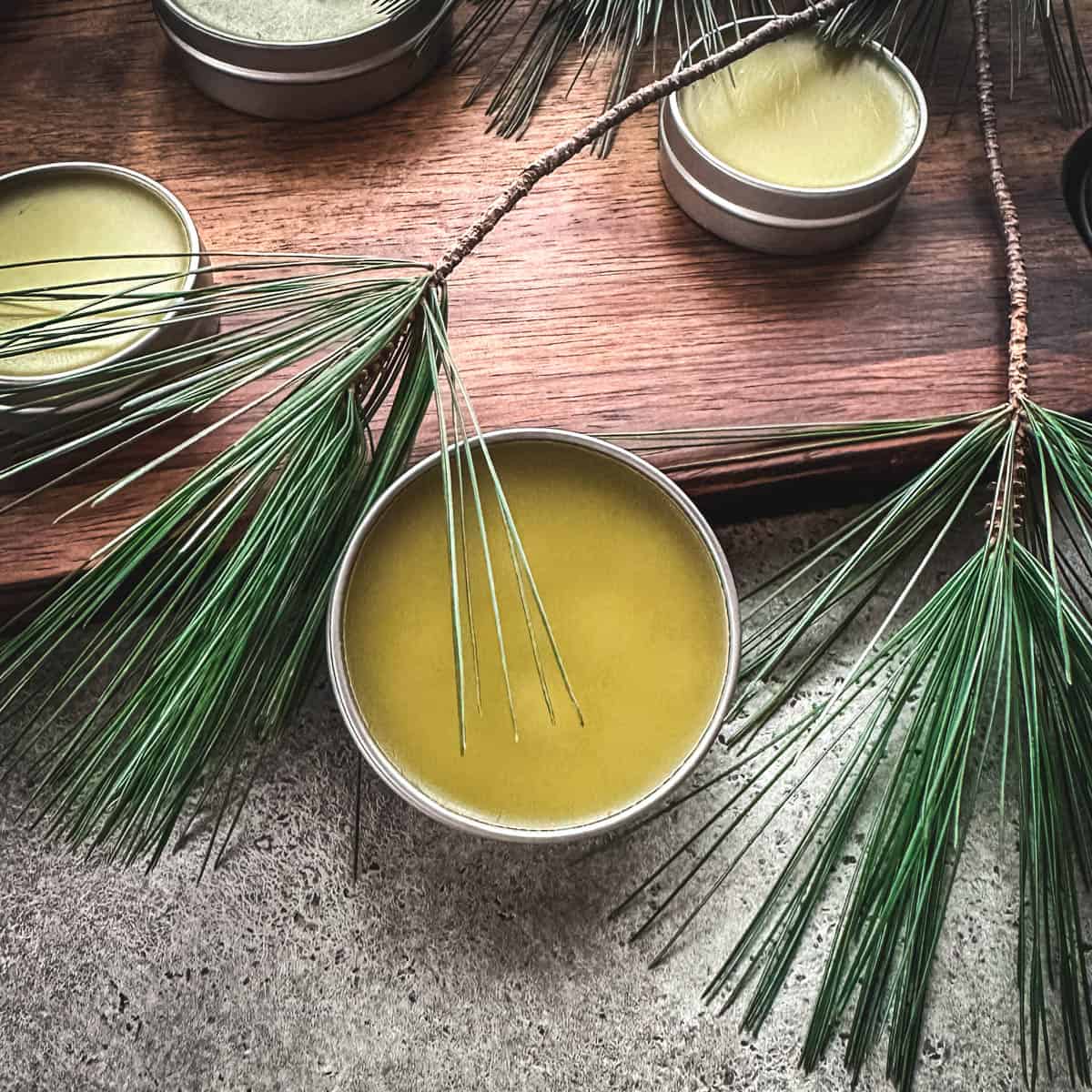
Want to save this post for later?
Foraging Pine Needles
Pine needles are readily available in most areas for winter foraging when other plants are sparse and asleep for the season. Pine and other conifer needles have many uses and tons of herbal uses!
This recipe starts with infused pine oil, and the very first step to making this lovely-smelling concoction is to know how to properly identify pine needles and other conifer needles for foraging.
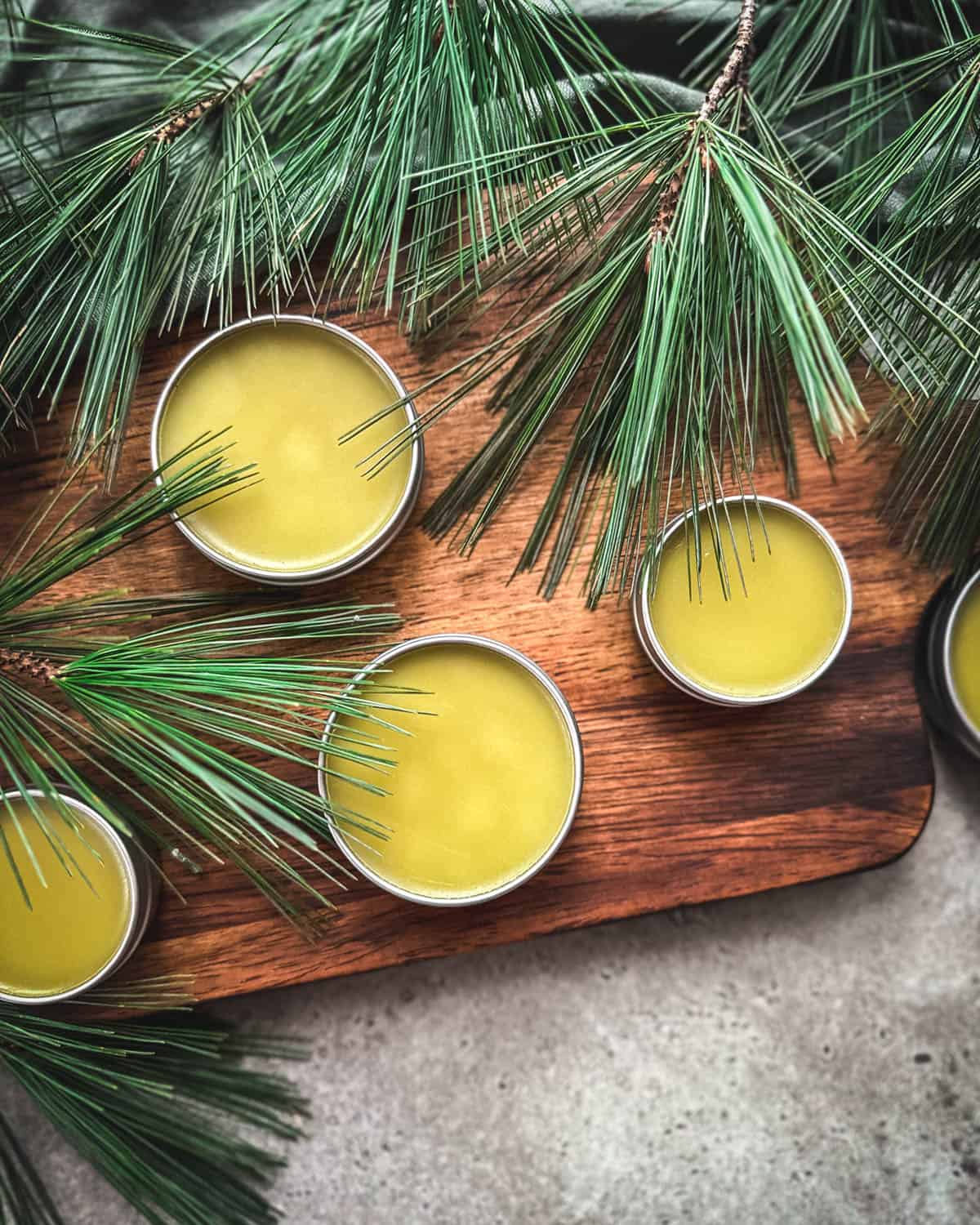
Pine and most other conifer needles are okay for making this pine salve, except for Yew, which is toxic.
Other than this main exception, along with pine, it’s okay to use conifer needles like fir, spruce, hemlock (the tree, not the poisonous plant), or Douglas-fir.
It’s even possible sometimes to use the needles from your Christmas tree to make a pine oil infusion, as long as you are sure it wasn’t sprayed with any chemicals, which is unfortunately common.
Pine Oil Herbal Properties
Infused pine oil has an amazing aroma and skin benefits that make it a wonderful salve for dry winter skin.
Pine needles and other conifer needles are warming, can help with circulation, and have pain-relieving properties that make them useful herbal allies for traditional herbalists.
Making an infused oil and a salve is an easy way to access the herbal properties of pine needles for soothing skin.
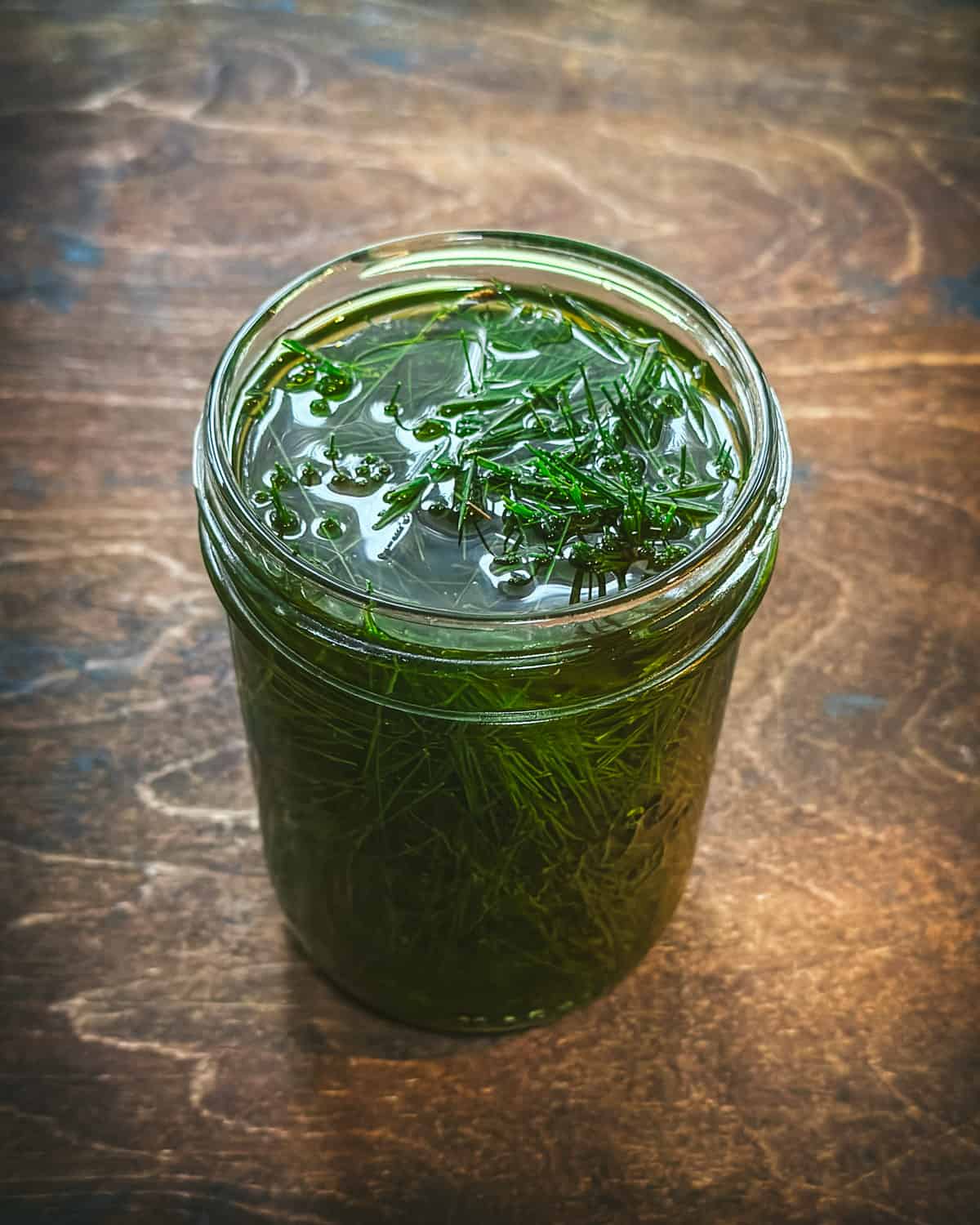
They are also soothing for dry and cracked skin, making this infused oil a perfect winter skin recipe for your apothecary. Pine salve is also a wonderful herbal gift since it is split into several tins.
If you are looking for other herbal skin soothing recipes, try making dandelion salve, plantain salve, calendula salve, or lavender salve.
Pine Salve Recipe
The pine needles in this recipe give the infused oil a little bit of pine scent, but not overwhelming. For a stronger smell, add essential oils when you are making the salve if you’d like.
I love fir needle and black spruce essential oils and used 12 drops of each when I made the salve, but scotch pine works and smells good too.
Ingredients
For the Pine Infused Oil
Pine needles: Or, other non-toxic conifer needles work just as well.
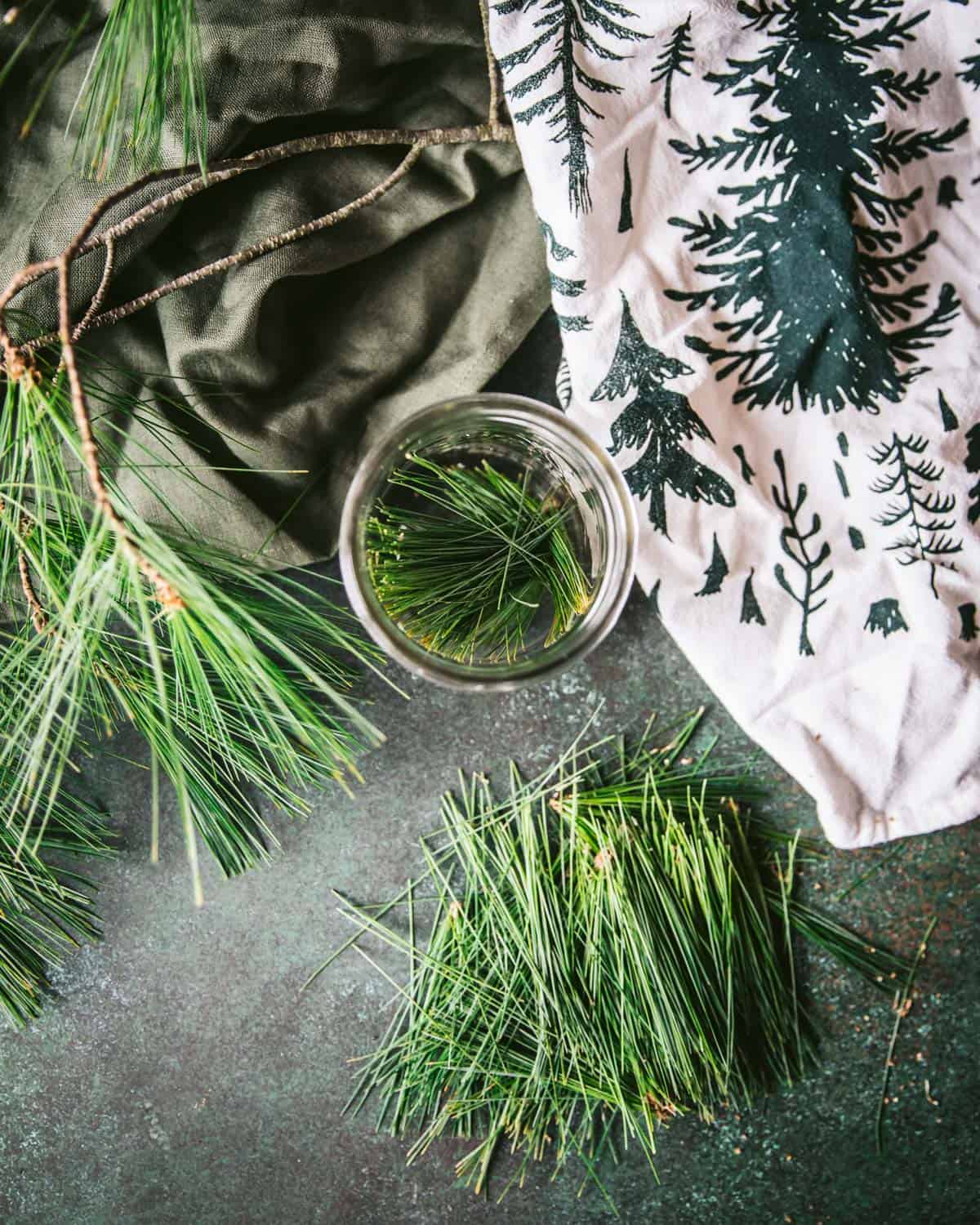
Olive oil: Extra virgin olive oil is an excellent choice as a carrier oil and is easy to find, but any carrier oil is okay to use. Each oil has its own properties, and which oil you use is really up to personal preference.
Castor oil: An optional ingredient that I recommend using, castor oil is very hydrating and works wonderfully to moisturize dry skin.
For the Pine Salve
Pine infused oil: Made as the first part of this recipe.
Beeswax: For all of my recipes containing beeswax, I buy it sustainably sourced from Mountain Rose Herbs.
Essential oil: These are completely optional, I recommend pine, fir, or spruce.
How to Make Pine Salve
The first step is to infuse the oil, which takes one to six weeks to be ready. This is an easy and low-maintenance way to infuse oil, and I feel it works the best.
Alternatively, you can use the quick method for making infused oils by heating the oil and pine needles in a pot on low heat for up to 12 hours. This works if you are short on time, but the infused oil may not be as potent.
How to Make Pine Oil
First, cut the pine needles into 1-inch pieces and put them in a half-pint jar. Cover them completely with olive oil, then add the optional castor oil.
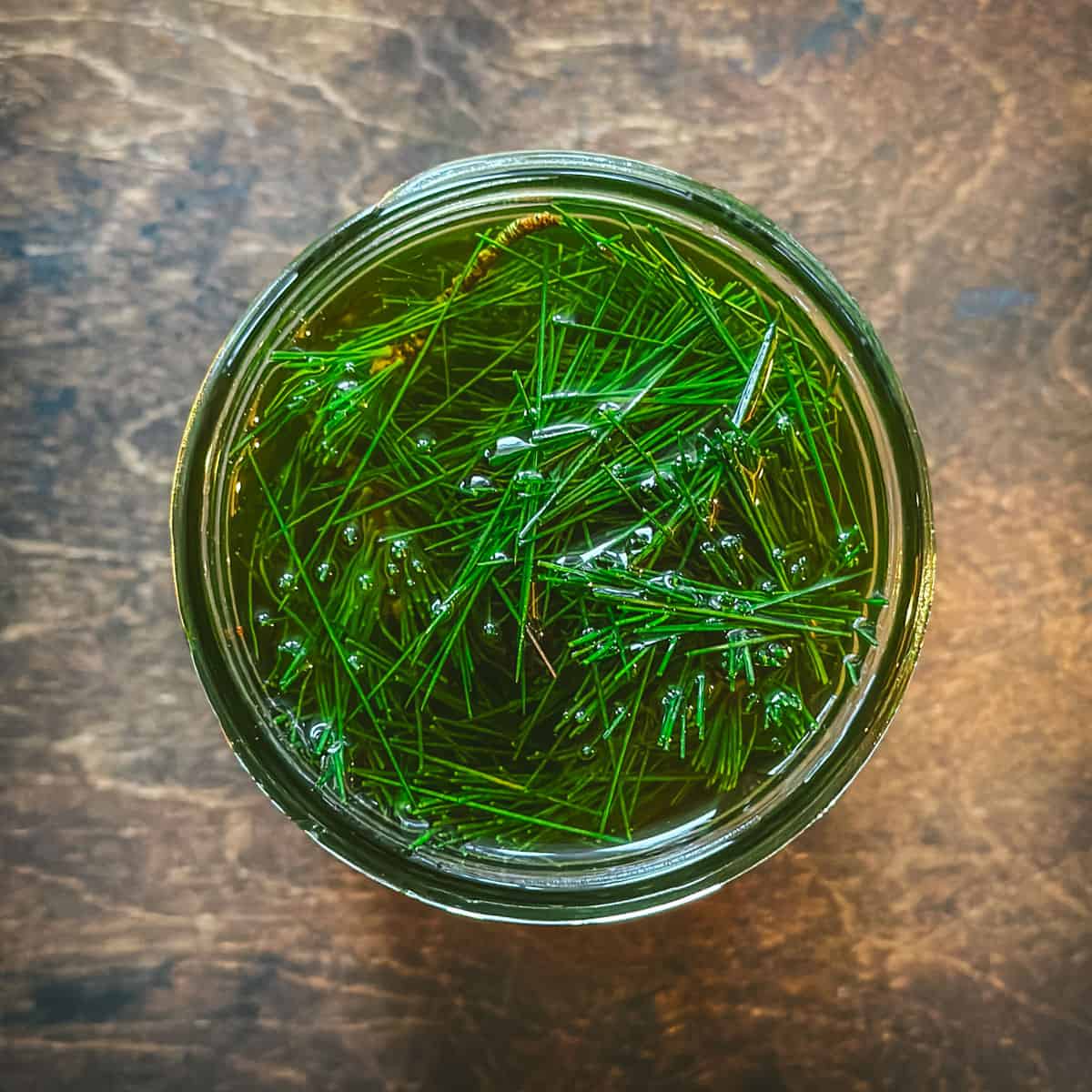
Then cover the jar with a lid and place it in a cool place that is out of direct sunlight, like in the pantry or a dark counter corner.
Let the oil infuse for at least a week and up to six weeks for the best results.
Once the oil is fully infused and you are ready to make the salve, strain out the pine needles. Reserve the infused pine oil to make the salve.
Make The Salve
First, create a makeshift double boiler by putting a smaller pan, bowl, or glass measuring cup in a larger pan that has an inch or two of water in it. Bring the water to a simmer.
Measure out 1 cup (240ml) of the pine-infused oil to use for making this pine salve. You can save any excess oil you may have to use topically or to make these pine lotion bars.
Now, put the pine oil into the double boiler to heat. Then add the beeswax to the oil and continue to heat until it completely melts. I find that a wooden skewer works best to stir until the beeswax melts.
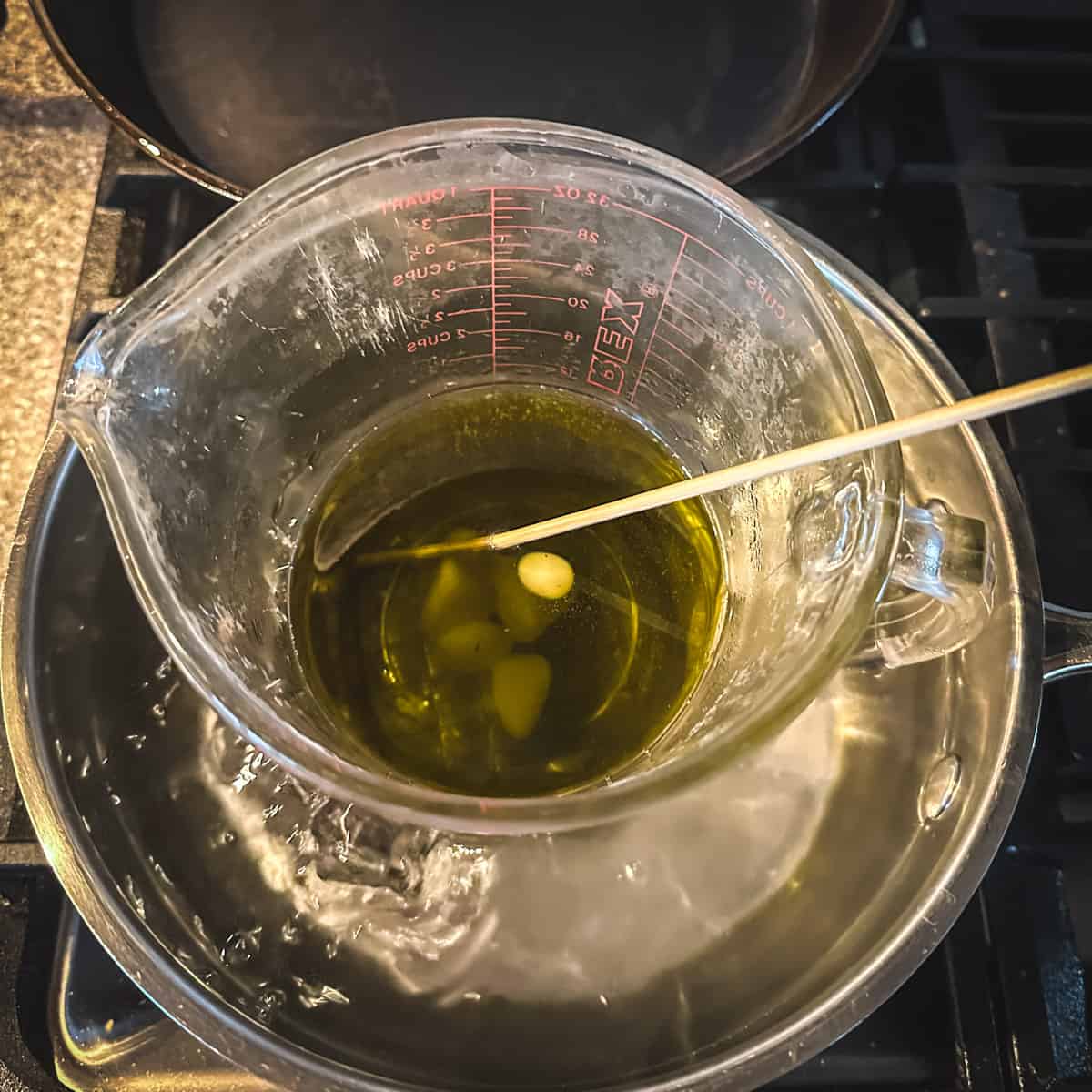
Then, remove the mixture from the heat and quickly stir in the optional essential oil drops if you choose to use it.
Once that is done, quickly and carefully pour the salve mixture into tins or jars.
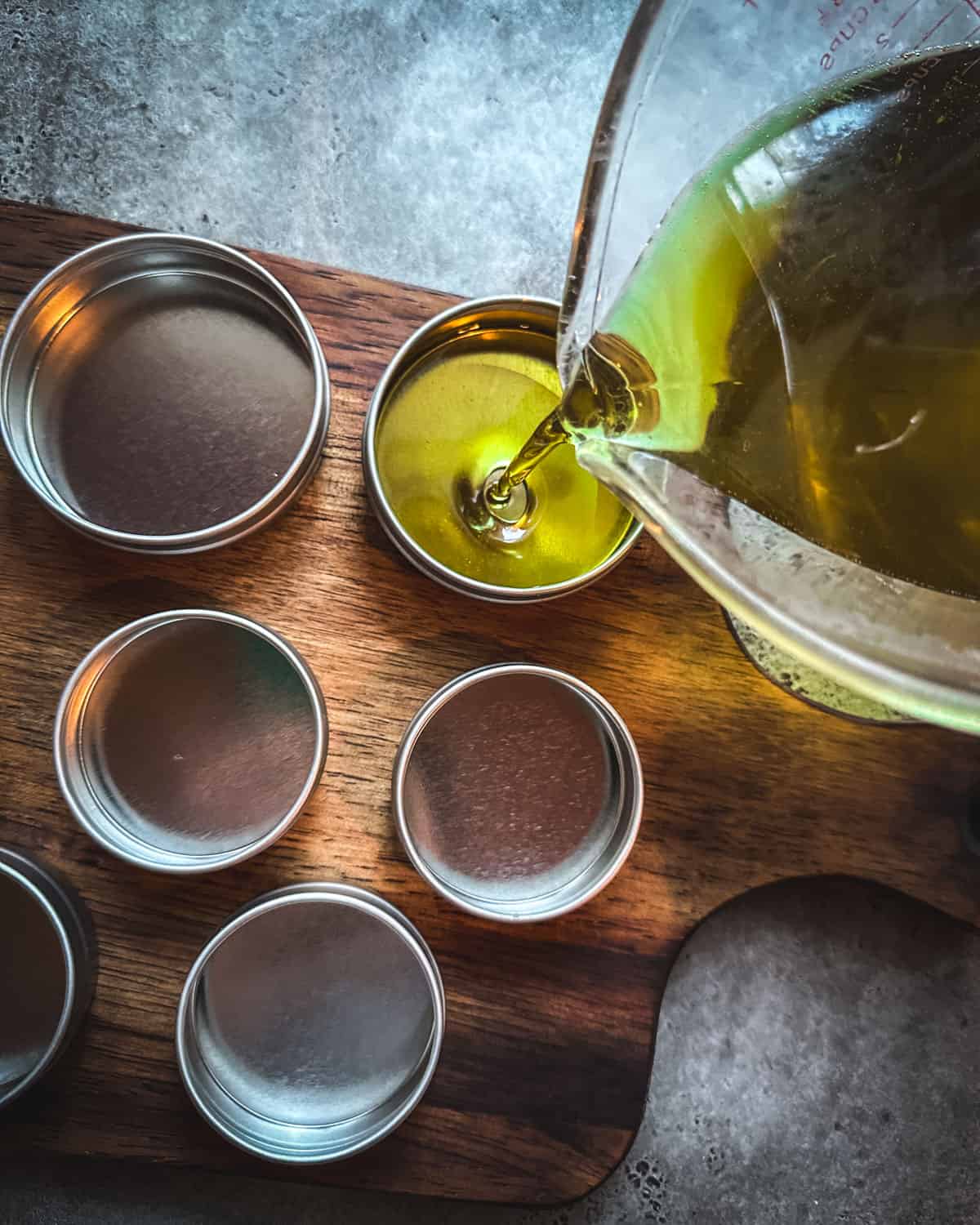
Let the salve sit undisturbed until it’s completely cooled. Make sure it’s cooled to room temperature and set up before using the pine salve, it will likely take several hours.

How to Use and Store Pine Salve
Pine salve serves as a soothing agent for dry, chapped, or irritated skin, particularly during the cold winter months. Use as often as necessary on any spots of irritation.
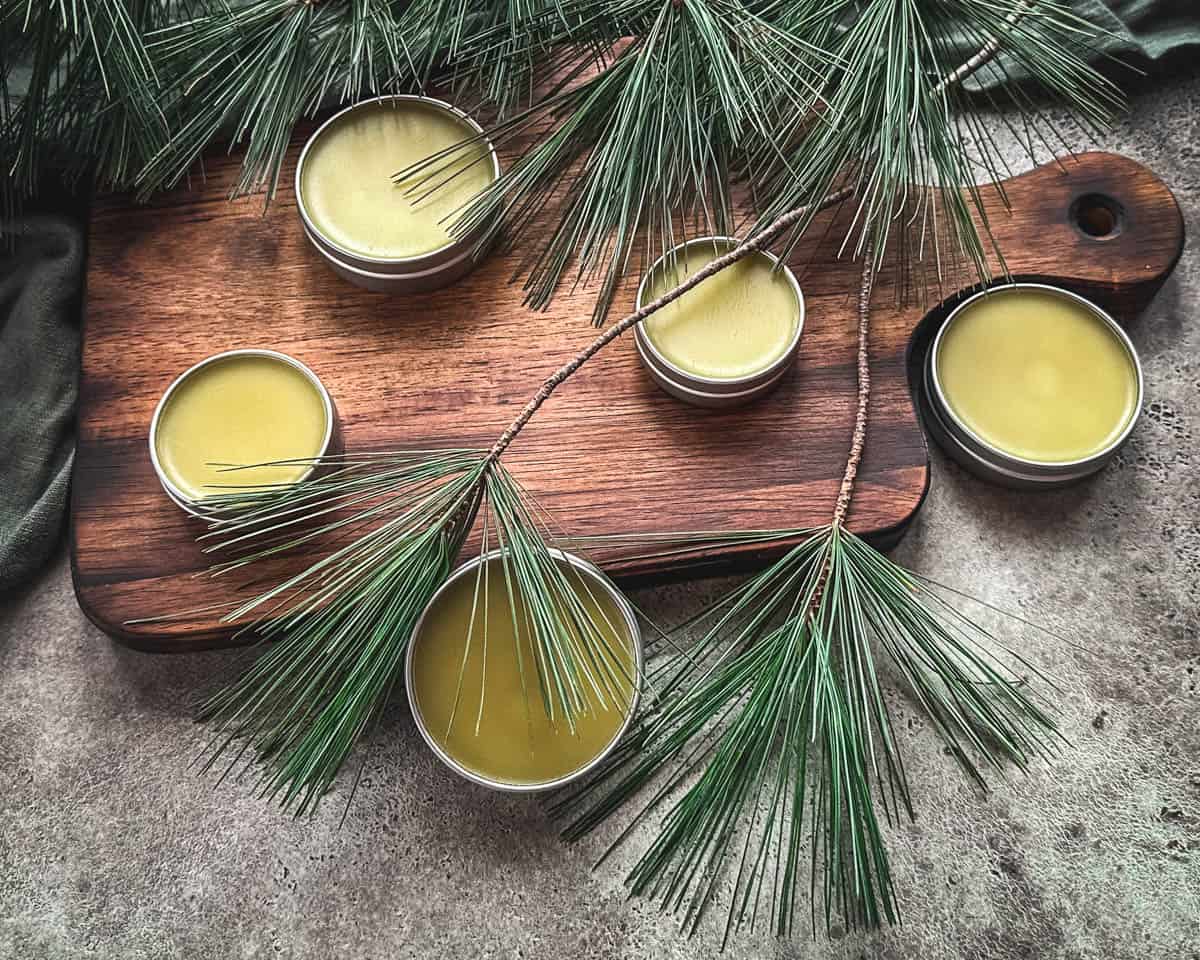
Salves work wonderfully to shield skin from over-drying, so feel free to use it as needed to protect the skin on your hands or anywhere that is often exposed to harsh weather.
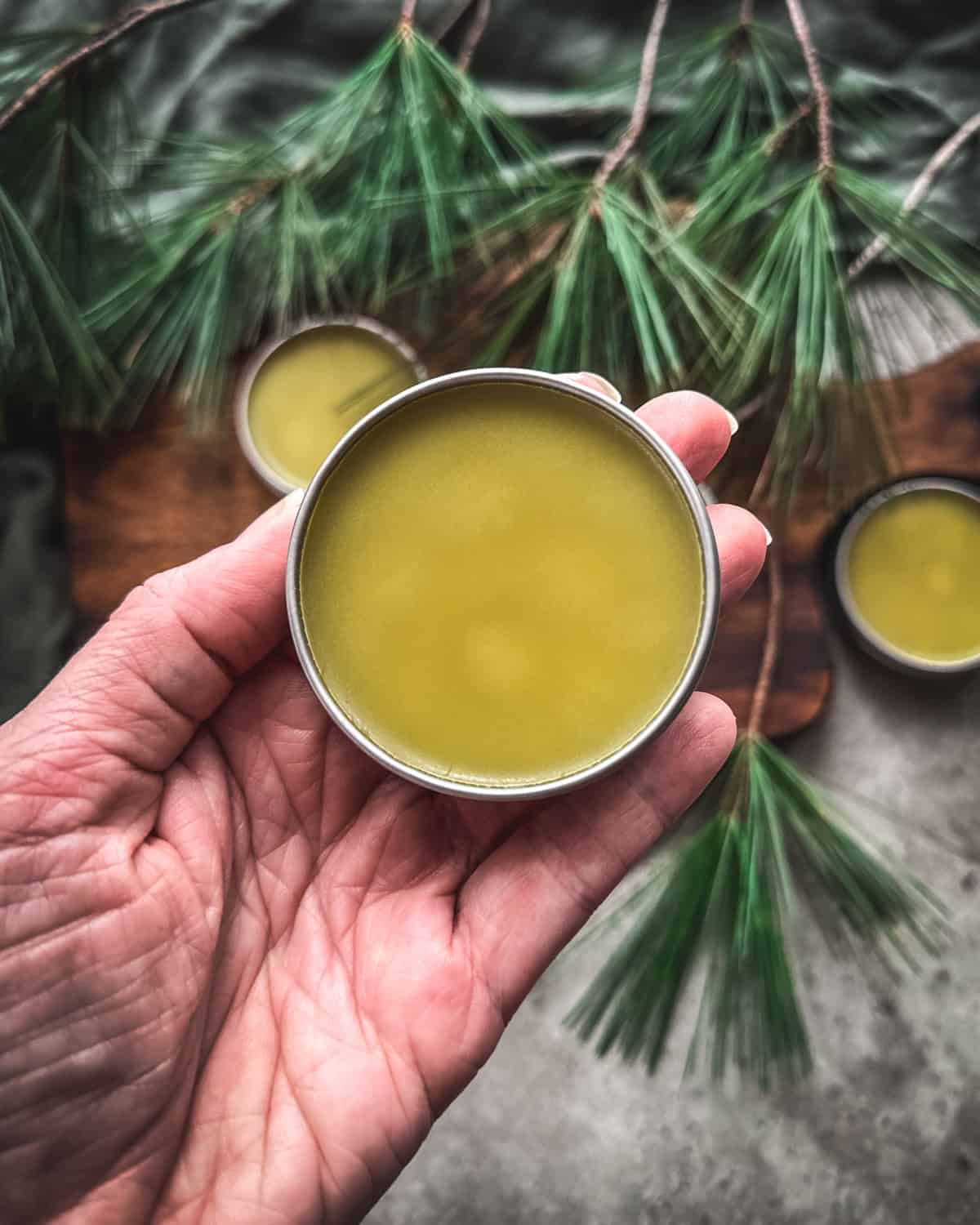
This pine salve smells like a day in the woods, so it will calm your spirits as well as soothe your skin! It will last a year or more if kept in a dry place away from intense heat and sunlight.
More Pine Needle Recipes
- Pine Needle Tea
- Pine Needle Cough Syrup
- Pine Lotion Bars
- Pine Needle Soda
- Conifer Infused Body Oil
- Pine Needle Cookies
- Pine Needle Infused Honey
- 30+ Pine Needle Recipes
- Conifer Tip Syrup
Pine Salve
Equipment
Ingredients
Pine Infused Oil
- 1 cup pine needles or other conifer needles
- 1 1/2 cup olive oil
- 1 tablespoon castor oil optional
Pine Salve
- 1 cup pine infused oil
- 1 ounce beeswax
- 24 drops pine, fir, or spruce essential oil (optional)
Instructions
Pine Infused Oil
- Cut the pine needles into 1-inch pieces and put them in a half-pint jar. Cover them completely with olive oil, then add the castor oil if using.
- Cover the jar with a lid and place in a cool place out of direct sunlight for at least a week and up to 6 weeks.
- Once the oil is fully infused and you are ready to make the salve, strain out the pine needles, reserving the infused oil.
Pine Salve
- Create a makeshift double boiler by putting a smaller pan, bowl, or glass measuring cup in a larger pan with an inch or two of water in it and bring the water to a simmer.
- Measure out 1 cup (240ml) of the pine-infused oil (save any excess oil you may have to use topically or use to make pine lotion bars).
- Put the oil into the double boiler. Add the beeswax to the oil and continue to heat until it completely melts. A wooden skewer works well as a stirrer. Then, remove the mixture from the heat.
- Quickly stir in the essential oil drops if using.
- Quickly and carefully pour the salve mixture into tins or jars.
- Let the salve sit undisturbed until it is completely cooled and set up before use. This will take several hours.

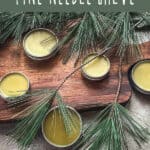
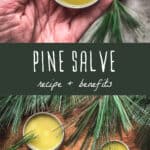


Thank you so much for this little recipe, I started my pine infused oil in October, I used Grapeseed oil for the carrier and Jojoba in place of Castor Oil, made my salve about a week ago, it has been a game changer, its completely cured my eczema on my hand that I have had for years and nothing has worked for it, it is definitely gonna me a staple in my medicine cabinet
I am new at this so of course I haven’t tried making the salve. I ha e several pine trees close to me but I’m waiting for the book to arrive that will identify the trees and or plants I need. I am eager to learn as much as I can about all natural recipes.
I’m further north, Washington, and my Blue Spruce has the new growth now. I plan on harvesting today. If one has too many to use up at once, would you dry, refrigerate or freeze them to use at a future time? BTW, I am thrilled to have found this information. Thank you sooo much!!
Hi Nanette. I would probably refrigerate or freeze any leftovers.
Do you have to dry out the pine needles before you make the oil? Will it mold if you don’t dry them first?
Hi Wendy. No, for this recipe you don’t. Pine needles don’t contain very much moisture and I have never had a problem with this salve molding.
Could you use shea butter instead of beeswax?
You can, but it won’t set up solid like a salve. It’ll be more like moisturizer.
What time of year is the best to harvest pine or spruce needles? Is there an optimal time to maximize the levels of nutrients you’re after with this salve? Thank You!
You can harvest them at any time, but generally, spring is the best time to forage for the new growth on conifer trees.